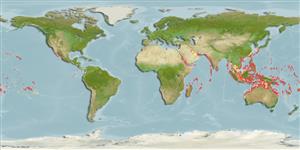>
Eupercaria/misc (Various families in series Eupercaria) >
Labridae (Wrasses) > Corinae
Etymology: Hologymnosus: Greek, holos = full + Greek, gymnos = naked (Ref. 45335).
More on author: Lacepède.
Environment: milieu / climate zone / rango de profundidad / distribution range
Ecología
marino asociado a arrecife; rango de profundidad 8 - 40 m (Ref. 90102). Tropical; 25°C - 28°C (Ref. 27115); 32°N - 28°S
Indo-Pacific: Red Sea and South Africa (Ref. 11228) to the Society and Pitcairn islands, north to southern Japan, south to southeastern Australia and Rapa Island.
Tamaño / Peso / Age
Madurez: Lm ? range ? - ? cm
Max length : 40.0 cm TL macho / no sexado; (Ref. 2334); common length : 34.0 cm TL macho / no sexado; (Ref. 5450)
Short description
Claves de identificación | Morfología | Morfometría
Espinas dorsales (total) : 9; Radios blandos dorsales (total) : 12; Espinas anales: 3; Radios blandos anales: 12. Two-color forms: the 'true' species in the Indian Ocean and Red Sea and its sibling in the Pacific regions. Females look almost black; males mainly greenish with blue face, of which Indian form shows a white band central to the body, whilst the Pacific form a pale peduncular area when in nuptial mode (Ref. 48636). Juvenile H. annulatus very closely resemble juvenile Malacanthus latovittatus (Ref.1602). Poorly developed pharyngeal teeth (Ref. 1602).
Body shape (shape guide): fusiform / normal; Cross section: compressed.
Found on coral reefs and rocky substrates to depths of at least 30 m (Ref. 9823) on offshore reef slopes (Ref. 90102). Juveniles generally solitary (Ref. 9710). Feeds primarily on small fishes, also on crustaceans (Ref. 2334).
Life cycle and mating behavior
Madurez | Reproducción | Puesta | Huevos | Fecundidad | Larva
Pelagic spawner.
Randall, J.E., G.R. Allen and R.C. Steene, 1990. Fishes of the Great Barrier Reef and Coral Sea. University of Hawaii Press, Honolulu, Hawaii. 506 p. (Ref. 2334)
IUCN Red List Status (Ref. 130435: Version 2025-1)
Threat to humans
Harmless
Human uses
Pesquerías: escaso valor comercial; Acuario: Comercial
Herramientas
Special reports
Download XML
Fuentes de Internet
Estimates based on models
Preferred temperature (Referencia
123201): 24.7 - 29.1, mean 28 °C (based on 602 cells).
Phylogenetic diversity index (Referencia
82804): PD
50 = 0.5625 [Uniqueness, from 0.5 = low to 2.0 = high].
Bayesian length-weight: a=0.00977 (0.00466 - 0.02049), b=3.07 (2.90 - 3.24), in cm total length, based on LWR estimates for this (Sub)family-body shape (Ref.
93245).
Nivel trófico (Referencia
69278): 4.2 ±0.73 se; based on food items.
Resiliencia (Referencia
120179): Medio, población duplicada en un tiempo mínimo de 1.4-4.4 años (Preliminary K or Fecundity.).
Fishing Vulnerability (Ref.
59153): Low to moderate vulnerability (30 of 100).
🛈
Nutrients (Ref.
124155): Calcium = 43 [26, 71] mg/100g; Iron = 0.598 [0.353, 1.077] mg/100g; Protein = 18.7 [15.8, 20.9] %; Omega3 = 0.144 [0.091, 0.223] g/100g; Selenium = 27.8 [16.1, 51.1] μg/100g; VitaminA = 174 [54, 589] μg/100g; Zinc = 1.07 [0.74, 1.62] mg/100g (wet weight);
